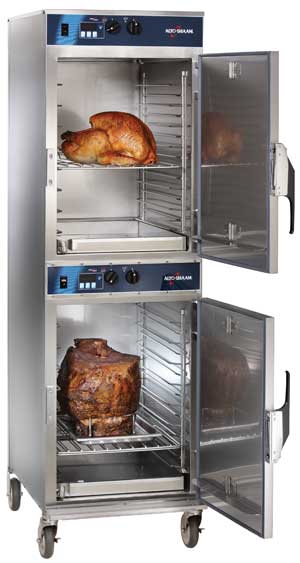Content sponsored by: Alto-Shaam
Though often misunderstood and underutilized, cook and hold ovens can bring an entirely new dynamic to any operation. Here, Robert Simmelink, Alto-Shaam Inc.’s executive chef and business development manager, provides information and tips on this valuable kitchen asset.
 Unlike conventional ovens, Alto-Shaam's cook and hold ovens can be used for long-term food holding, which helps maximize labor and production time.
Unlike conventional ovens, Alto-Shaam's cook and hold ovens can be used for long-term food holding, which helps maximize labor and production time.
- Because cook and hold ovens max out at 325 degrees F, these units are not designed for convection oven style cooking or for use as a production oven like combi and convection units. “This equipment is best used to cook low and slow, which provides higher yields and greater tenderization,” said Simmelink. “For this reason, one of the cook and hold ovens’ biggest benefits is being able to cook overnight.”
- While cook and hold ovens are often used for roasting large proteins, like prime rib and turkey, it’s important to remember that these units are extremely versatile. “In addition to roasting and braising, cook and hold ovens provide low-temp culturing and fermenting and long-cook sous vide,” said Simmelink. “The menu extension possibilities are huge with these units.”
- For operations needing to stage food prior to plating, these units also are commonly utilized as finishing ovens on the cook line.
- The majority of cook and hold ovens offer a smoking feature. “But because operators run the risk of crossover flavors when this feature is employed, the ovens then become dedicated smokers. “If both smoking and cooking are needed, these two cook and hold ovens can be stacked,” said Simmelink.
- Food holding length in these units is subjective in terms of the type of food and its density. For example, while a large roast can be held for as long as 24 hours, holding times for more delicate meats, like chicken breast, will be shorter.
 Alto-Shaam cook and hold ovens can be used for a wide range of production tasks, including baking, roasting, braising, sous vide, proofing and fermenting.
Alto-Shaam cook and hold ovens can be used for a wide range of production tasks, including baking, roasting, braising, sous vide, proofing and fermenting.
- When purchasing a cook and hold oven, operators need to decide if probes and preset features are needed, which will increase the purchase price. “Presets and probes are worth paying extra for because quality and consistency will be locked in, no matter what the variables are or who the user is,” said Simmelink. “The food will be exactly the same every time, and that’s what all operators strive to achieve. Operators also will have a HACCP record.”
- Cook and hold ovens need to be preheated to cook properly and work off the proper calculations. “Also, the initial warm air of a pre-heated oven sterilizes the food’s surface before the heat begins cooking,” said Simmelink.
- These ovens are economical to run, even overnight. Energy usage rates for the units range from $1 to $2 for 24 hours of use. Since this equipment doesn’t require a hood, the costs for overnight operation are eliminated.
- To ensure food safety and a long service life, cook and hold ovens should be cleaned after every cooking load. For Alto-Shaam units, the drip tray and side racks are easily removed and can be washed in a dish machine. The oven’s interior also can be cleaned with hot, soapy water. “The cleaning process for this equipment is typically five minutes or less,” said Simmelink.
- Alto-Shaam’s cook and hold ovens have minimal moving parts and are designed so food moisture cannot penetrate the insulation or controls. “These units are built like tanks and are very strong and reliable,” said Simmelink. “This equipment is an asset to any kitchen.”
Learn more about the benefits of cook & hold ovens at http://www.alto-shaam.com/en/landing-pages/cook-hold.




